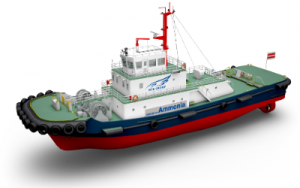Joint R&D for Ammonia-Fueled Tugboat

NYK, IHI Power Systems Co., Ltd., and Nippon Kaiji Kyokai (ClassNK) have signed a joint research and development agreement to put the world’s first ammonia-fueled tugboat into practical use.
With the entry into force of the Paris Agreement in 2016, global momentum for decarbonisation has increased, and reducing GHG emissions has become an issue in the shipping sector. In 2018, the International Maritime Organization (IMO) set a goal of halving GHG emissions from the international shipping sector by 2050 and reaching a target of zero as early as the end of this century. Since carbon dioxide (CO2) is not emitted when ammonia is burned, it is viewed to have promise as a next-generation fuel that could mitigate shipping’s impact on global warming. In addition, it is said that zero emissions can be realised by utilising CO2-free hydrogen* as a raw material for ammonia. For that reason, the three companies decided to start this joint R&D for an ammonia-fueled tugboat. The trio has previously worked together to jointly develop the LNG-fueled tugboat Sakigake**, which was built in 2015 as Japan’s first ship fueled by liquefied natural gas (LNG). In this new joint R&D project, they will utilise the knowledge cultivated in the development, construction, and operation of Sakigake.Overview of Joint R&D
The companies will proceed with R&D from both technical and operational aspects for the introduction of ammonia as a marine fuel for tugboats. They will tackle themes such as technological development of the hull, engine, and fuel supply system, and development of safety navigation methods. After evaluating the practicality of the R&D results, the companies will begin studying the construction of the ammonia-fueled tugboat and the construction plan.The initiatives of each company regarding this joint R&D are as follows.
| NYK Line |
|
| IHI Power Systems Co., Ltd. |
|
| Nippon Kaiji Kyokai (ClassNK) |
|
Future Outlook
The introduction of ammonia as a marine fuel is widely expected to be a practical solution for decarbonisation in the shipping sector. This joint R&D envisions the implementation of ammonia marine fuel in tugboats that require high output, and the three companies aim to firmly establish the technical and operational requirements for that purpose. If it is possible to commercialise marine equipment that uses ammonia, one of the next-generation fuel candidates, and establish a method to operate the vessel, they expect the Japanese maritime industry to make a significant contribution to decarbonisation of the international shipping sector.
* CO2-free hydrogen
One way to produce hydrogen without generating CO2 is through the use of renewable energy. A second way is by using natural gas or coal together with carbon capture and storage. CO2-free ammonia synthesis is technology for synthesizing ammonia using such CO2-free hydrogen.
** LNG-fueled tugboat Sakigake
Sakigake is owned by NYK Line and operated in Yokohama port and Kawasaki port under the navigation of Shin-Nippon Kaiyosha. Japan’s first LNG-fueled tugboat, Sakigake was built at Keihin Dock Co. Ltd. and is equipped with a dual-fuel engine that can use either LNG or diesel oil, depending on conditions. The tugboat’s engine was constructed by IHI Power Systems Co., Ltd. (Niigata Power Systems Co., Ltd. at the time of construction). When using LNG fuel, Sakigake becomes an eco-friendly tugboat compared to when using heavy oil because sulfur oxide (SOx) emissions are reduced by approximately 100%, nitrogen oxide (NOx) emissions by approximately 80%, and carbon dioxide (CO2) emissions by approximately 30%.






